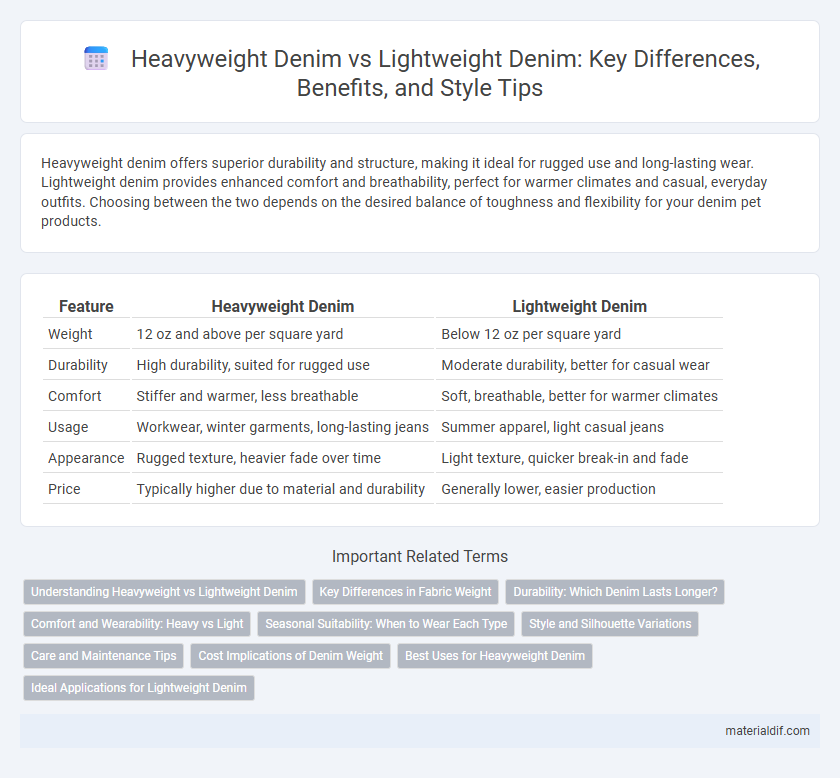Heavyweight denim offers superior durability and structure, making it ideal for rugged use and long-lasting wear. Lightweight denim provides enhanced comfort and breathability, perfect for warmer climates and casual, everyday outfits. Choosing between the two depends on the desired balance of toughness and flexibility for your denim pet products.
Table of Comparison
| Feature | Heavyweight Denim | Lightweight Denim |
|---|---|---|
| Weight | 12 oz and above per square yard | Below 12 oz per square yard |
| Durability | High durability, suited for rugged use | Moderate durability, better for casual wear |
| Comfort | Stiffer and warmer, less breathable | Soft, breathable, better for warmer climates |
| Usage | Workwear, winter garments, long-lasting jeans | Summer apparel, light casual jeans |
| Appearance | Rugged texture, heavier fade over time | Light texture, quicker break-in and fade |
| Price | Typically higher due to material and durability | Generally lower, easier production |
Understanding Heavyweight vs Lightweight Denim
Heavyweight denim, typically ranging from 14 to 16 ounces per yard, offers superior durability and is ideal for rugged wear and cold climates, while lightweight denim, usually under 12 ounces, provides enhanced breathability and comfort for warm weather. The thickness and weight affect the fabric's stiffness, break-in time, and overall garment longevity, with heavyweight denim requiring longer wear periods to soften. Selecting between heavyweight and lightweight denim depends on climate, intended use, and personal preference for fit and feel.
Key Differences in Fabric Weight
Heavyweight denim typically ranges from 12 to 16 ounces per square yard, offering greater durability, structure, and warmth, ideal for workwear and cold climates. Lightweight denim, often between 5 and 10 ounces per square yard, provides enhanced breathability and comfort, making it suitable for summer wear and casual styles. The significant difference in fabric weight directly impacts the denim's thickness, stiffness, and overall performance, influencing both comfort and longevity.
Durability: Which Denim Lasts Longer?
Heavyweight denim, typically ranging from 12 to 16 ounces per square yard, offers superior durability due to its dense weave and thicker yarns, making it ideal for heavy use and long-term wear. Lightweight denim, around 8 to 10 ounces per square yard, while more comfortable and breathable, generally wears out faster and is more prone to tearing and fading over time. Therefore, heavyweight denim lasts longer and withstands harsher conditions better than lightweight denim.
Comfort and Wearability: Heavy vs Light
Heavyweight denim, typically over 14 oz per square yard, offers durability and a sturdy feel but can be less comfortable for extended wear due to its stiffness and reduced breathability. Lightweight denim, usually under 12 oz, provides enhanced comfort and flexibility, making it ideal for daily activities and warmer climates. Choosing between heavyweight and lightweight denim depends on the desired balance between rugged durability and all-day wearability.
Seasonal Suitability: When to Wear Each Type
Heavyweight denim, typically above 14 oz, offers excellent durability and warmth, making it ideal for cooler seasons like fall and winter. Lightweight denim, generally below 12 oz, provides breathability and comfort suitable for spring and summer wear. Choosing denim based on weight ensures optimal comfort and functionality aligned with seasonal temperature variations.
Style and Silhouette Variations
Heavyweight denim provides a structured silhouette that enhances sharp, tailored styles, ideal for creating bold, durable fashion statements with classic rigidity. Lightweight denim offers greater flexibility and drape, allowing for softer, more relaxed fits that emphasize fluid movement and casual aesthetics. Style variations are deeply influenced by denim weight, where heavyweight favors structured jackets and raw denim jeans, whereas lightweight suits flowing skirts and slim-cut shirts.
Care and Maintenance Tips
Heavyweight denim requires less frequent washing to preserve its stiff texture and rich indigo color, while lightweight denim benefits from gentle machine washes and air drying to avoid shrinkage and fabric wear. Using cold water and mild detergents helps maintain the integrity of both types, with heavyweight denim often thriving from spot cleaning to extend its lifespan. Storing denim folded or hung in a cool, dry place prevents mildew and fabric damage, ensuring long-lasting durability for all denim weights.
Cost Implications of Denim Weight
Heavyweight denim typically costs more due to higher cotton content, increased durability, and longer production times, making it a premium choice for long-lasting garments. Lightweight denim, while less expensive to produce and purchase, may wear out faster and require more frequent replacement, impacting long-term value. Brands often price heavyweight denim higher to reflect quality, longevity, and the complexity of craftsmanship involved.
Best Uses for Heavyweight Denim
Heavyweight denim, typically weighing over 14 ounces per square yard, is best suited for durable workwear, rugged outerwear, and items requiring long-lasting strength and abrasion resistance. Its dense weave and thicker fibers provide superior protection and structure, making it ideal for motorcycle jackets, raw denim enthusiasts, and heavy-duty jeans designed for manual labor. This type of denim also develops unique fading patterns over time, enhancing its appeal for those seeking authentic, personalized wear.
Ideal Applications for Lightweight Denim
Lightweight denim, typically weighing between 4 to 8 ounces per square yard, excels in warm-weather clothing due to its breathable and flexible nature. It is ideal for summer shorts, shirts, and casual dresses where comfort and mobility are prioritized. Designers often select lightweight denim for layering pieces and sporty styles, maximizing ease of movement without sacrificing the classic denim aesthetic.
Heavyweight denim vs lightweight denim Infographic

 materialdif.com
materialdif.com